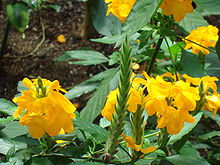- Crossandra infundibuliformis
-
Firecracker Flower Scientific classification Kingdom: Plantae (unranked): Angiosperms (unranked): Eudicots (unranked): Asterids Order: Lamiales Family: Acanthaceae Genus: Crossandra Species: C. infundibuliformis Binomial name Crossandra infundibuliformis
(L.) NeesSynonyms Justicia infundibuliformis L.
Crossandra undulifolia Salisb.Crossandra infundibuliformis, the Firecracker Flower, is a species of plants in the family Acanthaceae, often cultivated for its colourful flowers. This is a very popular tropical flower known as Firecracker. Its scientific name is Crossandra infundibuliformis and the family Acanthaceae. Family wise they are related to such houseplants as the Zebra Plant (Aphelandra squarrosa), Black-eyed Susan Vine (Thunbergia alata), Shrimp Plant (Beloperone guttata), Nerve Plants (Fittonia) and Ruellia. They are evergreen and bloom continuously almost throughout the year. They are sensitive to cold and can’t stand below 50*F. The plants are native to Southern India, Malaysia and Sri Lanka. It is usually grown in containers but can be attractive in beds as well. Flower colours range from the common orange to salmon-orange or apricot, coral to red, yellow and even turquoise. The flowers are unusually shaped with 3 to 5 asymmetrical petals. They grow from four-sided stalked spikes. They have a tube like ¾ inch stalk which makes it easier to string them for a garland. These tiny flowers are often strung together into strands, sometimes along with white jasmine flowers and therefore in great demand for making garlands which are offered to temple deities or used to adorn women’s hair. The flowers have no perfume but stay fresh for several days on the bush. A well tended specimen will bloom continuously for years. The leaves are glossy and most striking. It is propagated by seeds or cuttings.
The main reason they are known as "Firecrackers" is because their seed pods, which are found after the flower has dried up, tend to "explode" when near high humidity or rainfall. The "explosion" releases the seeds onto the ground, thereby creating new seedlings.
Its is popularly known as Kanakambaram flowers in Tamil & Telugu.

This Acanthaceae article is a stub. You can help Wikipedia by expanding it.

